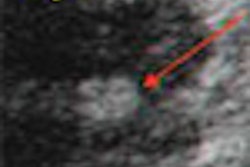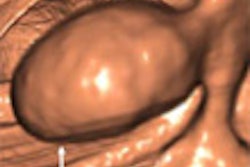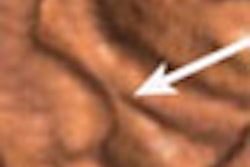Tagging protocols and electronic subtraction schemes are shaping up to be important issues in virtual colonoscopy today, as researchers seek to eliminate the uncomfortable cathartic bowel cleansing regimen used in VC, and, they hope, improve compliance rates for colorectal cancer screening.
In their quest for the best tagging agent, investigators typically look at one or perhaps two combinations with the qualities needed for reliable tagging.
The optimal tagging regimen would be a patient-friendly protocol that provides uniform homogeneity, uniform CT density, and high consistency of tagged contents to optimize the performance of electronic subtraction software, which in turn identifies and erases the tagged contents from the CT dataset, based on the relatively higher attenuation of tagged regions compared to the colonic mucosa.
"There are multiple possible tagging regimens for noncathartic minimal prep CTC (VC). However, there is little prospective comparison data evaluating or comparing these different regimens," said Dr. Michael Zalis from Boston's Massachusetts General Hospital in a presentation at the 2004 RSNA meeting in Chicago.
In their study, Zalis and colleagues evaluated not one but 11 different prep combinations administered in the 48 hours before CT imaging, and reported the five combinations with the best results at the RSNA meeting. According to their somewhat surprising results, all the protocols using iodinated nonionic contrast agents offered more effective tagging than the barium or meglumine amidotrizoate combinations.
"Our hypotheses were that 1) homogeneously tagged colonic contents would lead to higher subjective ratings from our readers, 2) patient comfort with tagging would be greater than patient comfort reported with standard cathartic bowel prep, and then finally, polyp detection with 'successful tagging' would be comparable to performance with a standard prep," Zalis said. "I include this caveat of 'successful' because ... we studied a wide variety of different preps, some of which were gross failures. I will spare you the data on those in great detail here."
The 11 protocols used three types of contrast media: iohexol (Omnipaque 300, 300 mg/mL iodine, GE Healthcare Bio-Sciences, Little Chalfont, U.K.), a nonionic iodinated contrast agent in 10 mL aliquots; meglumine amidotrizoate (Gastrografin, Schering, Berlin) in 7 mL aliquots that were equivalent to the iohexol in terms of total iodine dosage; and third, a 40% barium suspension (Tagitol V, E-Z-EM, Lake Success, NY).
The top five results all went to the nonionic iohexol preps, with the barium and Gastrografin protocols trailing in sixth place and beyond. Still, the cohorts were small, as were the statistical differences between the protocols deemed successful and those deemed unsuccessful.
"By power analysis (of the ANOVA test), we expected to be able to discern differences as small as 22% in success rate, with a power of 85% for relatively small cohorts," Zalis said. "This permitted us ... to look at a wide variety of different preps, which was really the aim at this phase of the study."
In addition to the three oral contrast agents, three additives were used among the 11 regimens, including 1) docusate sodium, an orally ingested surfectant; 2) magnesium citrate, a nonabsorbed osmotic sodium and meglumine salt (administered in noncathartic doses of either 16 g or 8 g taken the night before the exam); and 3) a gentle hydration regimen consisting of 10 oz of nondiuretic (nonalcoholic and noncaffeinated) fluid during the 48-hour tagging period, Zalis said.
Low-dose prone and supine CT was performed in all patients after the 48-hour cleansing regimen and manual room-air insufflation, Zalis said. The data were evaluated on a binary basis for the presence of polyps, all on a dedicated workstation, and blinded colonoscopy served as the reference standard.
The prep quality of each virtual colonoscopy exam was then evaluated on a 6-point scale (from 1 being uninterpretable, to 6 being excellent), and further dichotomized as a success (score 4+) or a failure (score < 4).
Partial results showed that the top regimens, in order of success rate, were:
10 mL/meal iohexol (300 mg/mL iodine) plus supplemental 64 oz hydration per day, plus a half dose (8.2 mg) of citrate the night before the CT exam (9/10, 90% success)
10 mL/meal iohexol (300 mg/mL iodine) plus supplemental 30 oz hydration per day, plus 16.4 mg of citrate the night before the exam (12/15, 80% success)
10 mL/meal iohexol (300 mg/mL iodine) plus 16.4 mg of citrate the night before the exam (11/15, 75% success)
10 mL/meal iohexol (300 mg/mL iodine) plus supplemental 30 oz hydration per day, plus a half dose (8.2 mg) of magnesium citrate the night before the exam (10/19, 53% success)
10 mL/meal iohexol (300 mg/mL iodine) plus 200 mg of docusate sodium (4/19, 21% success)
300 mg of a 40% barium suspension plus a half dose (8.2 mg) of magnesium citrate and hydration, or alternatively, 7 mL/meal meglumine amidotrizoate plus a half dose (8.2 mg) of magnesium citrate and hydration. (Differences between the barium sulfate mixture and all meglumine amidotrizoate combinations were statistically insignificant.)
"Basically the nonionic (contrast regimens) clustered without any significant differences in terms of the success rate between them," Zalis said. "There were significant differences between the addition of ducosate and all the other nonionic preps, where ducosate essentially ruined the nonionic prep and made it a worse prep (per number 5 above). Similarly, there was significant difference between barium and the nonionic preps, but no significant difference in our hands between the barium and the Gastrografin, which may in part be due to a dosing-related issue."
In response to a questionnaire handed out before the exam and collected immediately afterward, the subjects reported mean comfort scores (discomfort and difficulty with prep), based on a 5-point scale (1 indicating minimal discomfort and difficulty, and 5 being maximal response), at between 1.5 to 1.8 among the top five groups, and the differences were not statistically significant (p > 0.05), Zalis wrote in his RSNA abstract.
Finally, the group compared the performance of virtual colonoscopy with that of conventional colonoscopy performed after VC, Zalis said. In pooled performance of all exams with a successful prep, 3/3 lesions 1 cm or greater were detected, and 2/3 lesions 6 mm or greater were detected.
The polyp detection results using only the results of the preps deemed successful produced a small improvement in sensitivity compared with the results using all preps, but no overall difference in specificity between the so-called successful and unsuccessful preps, Zalis said. Still, he added, the relatively small cohorts for each regimen were a principal limitation at this stage of the study, permitting only gross comparisons of polyp detection and characterization, as well as subject preferences.
The results were encouraging overall, Zalis said, and similar to those obtained with traditional cathartic preps.
By Eric Barnes
AuntMinnie.com staff writer
January 27, 2005
Related Reading
Laxative-free VC appears promising, November 10, 2004
VC antispasmodics show mixed distension results, real patient-acceptance gains, August 27, 2004
Reduced-prep VC with tagging works after failed colonoscopy, March 7, 2004
German group optimizes barium-sulfate tagging in MR colonography, January 22, 2003
In virtual colonoscopy, nothing beats a good prep, July 16, 2002
Fecal tagging improves detection in virtual colonoscopy, August 29, 2002
Copyright © 2005 AuntMinnie.com



















